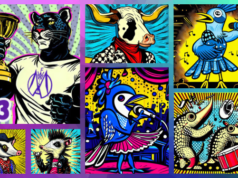I spent last week in the deserts of Arizona, where a great new museum just opened up this past spring. The Musical Instrument Museum is an offshoot of a similarly named institution in Brussels, Belgium, and it’s the largest museum of its kind in the world. Among its 13,000 musical instruments are some pieces of historical value, like John Lennon’s piano. The building itself is a striking piece of architecture designed by the firm of RSP Architects, with a distinctive façade of polished wood panels. The auditorium there has quickly become an important concert venue for various kinds of music. The galleries contain musical instruments from nearly every country on earth, including Vanuatu, Nauru, San Marino, and the Comoros Islands. (It’s easier to list which countries aren’t represented. I counted Libya, which is odd, and São Tomé e Principe.)
Yet maybe the best feature of this place is the infrared headphones. Since you’re not allowed to play the instruments on display, the museum offers video and audio clips so that you can see the instruments being played and hear what they sound like. You keep a pair of headphones on at all times, and when you walk near an exhibit, the audio automatically switches to what you’re seeing. These make up an ethnomusicological treasure trove of music from hundreds of different cultures. They also show that music isn’t just something you experience in a concert setting. It’s used in theater, dance, storytelling, religious ritual, and communal gathering.
I thought I’d list some of the ones that caught my ear, with the artist’s name in parentheses. Where possible, I tracked down the same clips on display at the museum:
Untitled (Northern Cree Singers) The nasal, high-pitched singing style of these Native Americans and the rhythmic power of their drumming creates an electrifying effect.
Al Maestro con Nostalgia (Carlos García) The silky elegance and melancholy of Argentinian tango, expressed in piano, strings, and bandoneón. The museum’s clip had a live performance conducted by Gustavo Santaolalla, but this is a pretty good substitute.
Rushnyk (Stepan Shcherbak) The word “rushnyk” means an embroidered towel used for ceremonial events. You’re probably thinking, “This guy’s singing this haunting, impassioned song about housewares?” Actually, the lyrics refer specifically to one given to the singer by his mother, so that whenever he looks at it, he’s reminded of his home. By the way, he’s playing a bandura, the national instrument of the Ukraine.
Jenny Jenkins (Jean Ritchie and Pete Seeger) Actually, I wanted to include Jean Ritchie singing “Ginny Get Around,” which is on display at the museum along with this clip, but the other song isn’t on YouTube. This Kentucky folk singer’s distinctive voice seems to speak directly from the Appalachian dells.
Bach’s Concerto for Two Keyboards in C major (Katia and Marielle Labèque) The Labèque sisters never got their due because they always played together, never solo, and because they weren’t shy about using their sultry images to sell records. As you can tell from this clip, they were still really good.
Čystaja-Śvietlaja (N.R.M.) Welcome to the wacky world of Belarusian rock music, protest songs with a dash of traditional Eastern European instrumentation and a whole lot of early 1990s grunge sound. The band N.R.M. has earned an international following for their chops and their willingness to criticize the government of their country, the last dictatorship still standing in Europe. Unfortunately, I don’t have a translation of the lyrics. Are there any Belarusian-speaking readers who can help?
So What (John Coltrane and Miles Davis) At the risk of coming off like a hipster cliché, I couldn’t in good conscience leave off this monument of bebop.
Untitled (Dimi Mint Abba) The forceful voice of this Mauritanian singer is an inspiration to women across North Africa and throughout the Arabic-speaking world.
The Holiday Evening (Etugen group) These Mongolian orchestras create a lush sound with relatively few instruments. That sound goes well with the rolling hills in the background. This isn’t the same clip as the one in the museum, but it looks and sounds much the same, and there are more on YouTube where they came from.
Sari Gelin (Alim Qasimov) The golden voice of this singer from Azerbaijan is hypnotic in its power. This clip isn’t in the museum. The museum instead has a clip of him teaching a little girl how to sing in the folk style known as mugham, and she’s just the cutest thing.
Marina, Marina (Los Texmaniacs) The rich harmonies of this San Antonio band represent the sounds of conjunto music in fine fashion. This entire museum can be described as a conjunto project, so this is as good a place to end as any.











